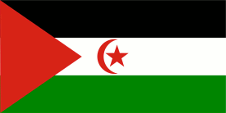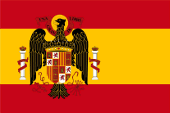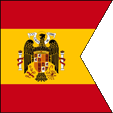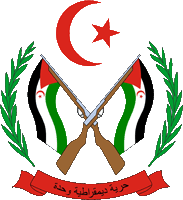Westsahara |
|
|
|
| Übersicht – Contents: | |
Diese Seite ist Teil des Projektes
Westsahara |
|
|
|
| Übersicht – Contents: | |
Flagge – Flag: |
|
 |
Flagge der Sahara-Republik – flag of the Sahara Republic, Seitenverhältnis – ratio = 1:2, Quelle/Source, nach/by: Wikipedia (EN)   |
historische Flaggen – historical Flags: |
|
 |
1945–1976, Flagge von Spanien – flag of Spain, Seitenverhältnis – ratio = 2:3, Quelle/Source, nach/by: Wikipedia (EN) |
 |
1945–1976, Standarte des Gouverneurs von Spanisch-Sahara – standard of the Governor of Spanish Sahara, Seitenverhältnis – ratio = 1:1, Quelle/Source, nach/by: Die Welt im bunten Flaggenbild |
| Die Flagge wurde am 27.02.1976 eingeführt. Sie zeigt die panarabischen Farben in drei waagerechten Streifen in Schwarz, Weiß und Grün, und am Liek ein gleichschenkliges rotes Dreieck. Im weißen Streifen ein roter Halbmond und ein roter Stern. Der Halbmond und der Stern sind islamische Symbole. Rot ist die Farbe des Sozialismus. | The
flag was
introduced on 27th of February in 1976. It shows the pan-arabian colours in
three horizontal stripes in black, white and green and on the leech an
isosceles red triangle. In the white stripe a red half-moon and a red star. The half-moon and the star are islamic symbols. Red is the colour of socialism. |
| Der Farbenvierklang von Grün, Weiß, Schwarz und Rot ist ein speziell arabisches Farbsymbol, die Panarabischen Farben. Die (pan)arabischen Farben wurden während des 1. Weltkriegs, bei der Loslösung des Königreichs Hedschas vom Osmanischen Reich, durch den Scherifen Hussein von Mekka – aus dem Geschlecht der Haschemiden – als Farben der Arabischen Bewegung offiziell eingeführt. Als Vorlage diente die Flagge des Hedschas. Die Farben haben folgende Bedeutung: Rot ist die Farbe von Omar, dem zweiten Kalifen; Weiß steht für die Omajiaden, eine Kalifendynastie, die auf den fünften Kalifen Moawija I. zurückgeht; Grün steht für die Fatimiden, eine ismailitisch-schiitische Kalifendynastie, die auf den vierten Kalifen Ali zurückgeht; und Schwarz steht für die Abbasiden, eine Kalifendynastie, die auf den Kalifen Abbas I. zurückgeht. Rot ist außerdem die Farbe der Haschemiden, eine arabische Herrscherdynastie, die wahrscheinlich auf Haschim ibn Abd al-Manaf, den Großvater Mohammeds, zurückgeht. Grün ist außerdem die Farbe des Islam im Allgemeinen, und bezieht sich somit nicht nur auf die arabischen Länder. | The
colour quartet of four, green, white, black and red is a special Arabian
colours symbol, the Panarabian colours. The (Pan)Arabian colours were
officially introduced by the Sheriff Hussein of Mekka – of the lineage of
the Hashemides – as colours of the Arabian Movement during the First World
War at the secession of the Kingdom of Hedjas from the Ottoman Empire. The
flag of Hedjas served as pattern. The colours have the following meaning: Red is the colour of Omar, the second calif; white stands for the Omajiades, a calif-dynasty, which goes back to the fifth calif Moawija I.; green stands for the Fatimides, a ismailitic-shiit calif-dynasty, which goes back to the fourth calif Ali; and black stands for the Abbasides, a calif-dynasty, which goes back to the calif Abbas I. Red is also the colour of the Hashemides, an Arabian sovereign-dynasty, which probably goes back to Hashim ibn Abd al-Manaf, the grandfather of Mohammed. Green is in addition generally the colour of Islam, and does not refer only to the Arabian countries. |
| Der islamische Symbolismus, in Form von Halbmond und Stern, geht auf das Osmanische Reich zurück. Der letzte Kalif (aus dem Haus der Abbasiden) war 1258 hingerichtet worden. Der Kalif, Nachfolger Mohammeds, war religiöses und weltliches Oberhaupt des "Islamischen Reichs". Um 1460 wurde das Kalifat vom Herrscher des Osmanischen Reichs wiederbelebt. Diese Funktion wurde besonders wichtig als die Türken im Jahre 1517 die Stadt Mekka eroberten, und die Funktion der obersten Hüter und Bewahrer der heiligen Stätten übernahmen. Die Kontrolle über die heiligen Stätten ging während des Ersten Weltkriegs verloren (Mekka 1916, Medina 1918). Das Kalifat wurde 1924 von der türkischen Nationalversammlung abgeschafft. | The
islamic symbolism, with thw half-moon and the star, is from Ottoman origin.
The last Calif (from the house of the Abbaside's) was executed in 1258. The
Calif – successor of Mohammed – was the religious and worldly head of the
"Islamic Empire". About 1460 the Califate was revitalized by the ruler of
the Ottoman Empire. This function became more important as the Turks
conquered Mecca Town in 1517, as they became the supreme protectors and
preservers of the holy places. The control over the holy places got lost during the First World War (Mecca 1916, Medina 1918). In 1924 the Califate became abolished by the Turkish national congregation. |
| So haben sich Halbmond und Stern als Symbole des Islam in der ganzen Welt verbreitet. Die Verbindung dieser Symbole mit grünen Flaggen hat ihren Ursprung im osmanischen Panislamismus. Als es in Teilen des Osmanischen Reiches zu Unabhängigkeitsbewegungen kam, setzte Abdul Hamid II. diesen Bewegungen erfolgreich das einigende Band des Panislamismus entgegen. Zum Symbol des Panislamismus machte er eine grüne Flagge (Farbe des Mantels des Propheten Mohammed), und setzte das türkische Wappen darauf. Die Flagge des Islam war erschaffen. | In this
way became half-moon and star spreaded in the whole world as the Symbols of
Islam. The coupling of that symbols with green flags has its roots in the
ottoman panislamism. As there arised independence
movements in some regions of the Ottoman Empire, encounts Abdul Hamid II.
these movements successful with the unifying string of panislamism. To the
symbol of the panislamism he made the green flag (colour of the overcoat of
the Prophet Mohammed), and layed above the Turkish coat of arms. The flag of
the Islam was created. |
| Quelle/Source: Die Welt der Flaggen, Volker Preuß | |
Wappen – Coat of Arms: |
|
 |
1955–1975, Wappen von Spanisch-Sahara – coat of arms of Spanish Sahara, Quelle/Source, nach/by: Wikipedia (EN) |
 |
Wappen der Sahara-Republik – coat of arms of Sahara Republic, Quelle/Source, nach/by: Wikipedia (EN) |
| Das Wappen der Spanischen Sahara war rot mit einem grünen Herzschild, darauf eine diagonale weiß-blaue Wellenlinie, oberhalb eine Palme, unterhalb ein Kamel. Der rote Rand zeigte abwechselnd die Symbolik von Kastilien und einen silbernen Löwen. Das Wappen der Sahara-Republik zeigt zwei gekreuzte Gewehre (Kampf für die Freiheit) mit jeweils einer Flagge der Sahara Republik, darüber Halbmond und Stern in Rot (Islam), darunter ein rotes Spruchband mit der arabischen Inschrift: "Hurriya, Dimuqratiya, Wahda" → "Freiheit Demokratie Einheit". Rechts und links befinden sich zwei Olivenzweige (Frieden). |
The coat of arms of the Spanish Sahara was red with a green central shield,
on it a diagonal white-blue wavy line, above a palm tree, below a camel. The
red border showed alternately the symbolism of Castile and a silver lion.
The coat of arms of the Sahara Republic shows two crossed rifles (fight for freedom) each with a flag of the Sahara Republic, above it a crescent and star in red (Islam), below it a red banner with the Arabic inscription: "Hurriya, Dimuqratiya, Wahda" → "Freedom Democracy Unity". On the right and left are two olive branches (peace). |
|
Quelle/Source: Wikipedia (EN) |
|
| Landkarte – Map: |
|
| Zahlen und Fakten – Numbers and Facts: | |
| Westsahara – Western Sahara | |
|
|
|
|
|
|
|
|
|
|
|
|
|
|
| Republik Sahara – Sahrawi Republic | |
|
|
|
|
|
|
|
|
|
|
|
|
|
|
|
|
|
|
| 11.–12.
Jhd. · zum Reich der Almorawiden 1434 · der portugiesische Seefahrer Gil Eannes umfährt Kap Bojador und entdeckt die heutige Küste von Westsahara 15.–19. Jhd. · Portugiesen und Spanier treiben an der Küste Handel, errichten Häfen und Handelsplätze 1884 · Spanien beginnt mit der Kolonisierung der Küste 1885 · Spanien erklärt den Küstenstreifen zwischen Kap Bojador und Kap Blanc zum spanischen Protektorat Rio de Oro 1946 · Rio de Oro wird mit der Stadt Ifni (im heutigen Marokko, bereits 1860 in Besitz genommen) zur Kolonie Spanisch-Westafrika zusammengefasst 1958 · Río de Oro und Saguia Al Hamra werden zur spanischen Überseeprovinz Spanisch-Sahara erklärt (Provincia Española de Sáhara) 1968 · Spanien ignoriert die UNO-Resolution 2428 zur Vorbereitung der Unabhängigkeit von Spanisch-Sahara, Gründung von ersten Befreiungsbewegungen 1972 · Spanien beginnt mit dem Abbau von Phosphat 1973 · Gründung der POLISARIO (Volksfront für die Befreiung von Saqiya al-Hamra und Rio de Oro), Beginn des Unabhängigkeitskampfes 1975 · Marokko provoziert einen gigantischen gewaltlosen Einmarsch in die Spanische Sahara, Spanien gibt die Kolonie auf, Marokko und Mauretanien teilen das Land und übernehmen provisorisch die Verwaltung 1976 · Abzug der letzten spanischen Truppen, die POLISARIO proklamiert in Bir Lehlou die Demokratische Arabische Republik Sahara (DARS) am 27. Februar, Marokko und Mauretanien annektieren die von ihnen verwalteten Gebiete 1979 · Mauretanien verzichtet auf seinen Teil der Westsahara zugunsten der POLISARIO und der DARS, Marokko annektiert auch dieses Gebiet 1982 · die DARS wird in die OAU aufgenommen, Marokko verlässt darauf hin die OAU 1984 · insgesamt 60 Staaten haben die ADRS seit 1976 diplomatisch anerkannt 1988 · UNO-Friedensplan, Verhandlungen zwischen Marokko und POLISARIO 1989 · die Verhandlungen zwischen Marokko und der POLISARIO bleiben ohne Ergebnisse 1991 · Waffenstillstand, Planung einer Volksabstimmung über die Unabhängigkeit durch die UNO 1993 · erneute Verhandlungen zwischen Marokko und der POLISARIO bleiben wieder ohne Ergebnisse 1995 · Verhaftung von über 100 DARS-Demonstranten in El Aaiun 1996 · die UNO stellt die Registrierung von Wählern vorübergehend ein, die POLISARIO droht mit neuem Krieg 1999 · die marokkanische Polizei beendet im ganzen Land pro-DARS-Demonstrationen 2000 · erneute Verhandlungen zwischen Marokko und der POLISARIO, pro-DARS-Demonstrationen El Aaiun 2020 · die POLISARIO erklärt den Kriegszustand |
| 11th–12th
cent. · to the Empire of the Almoravides 1434 · the Portugese seafarer Gil Eannes passes Cape Bojador and discovers the today’s coast of West Sahara 15th–19th cent. · Portugese and Spaniards trade at the coast, establish ports and trade points 1884 · Spain begins with the colonization of the coast 1885 · Spain declares the coast line between Cape Bojador and Cape Blanc to the Spanish protectorate Rio de Oro 1946 · Rio de Oro becomes summarized with the City of Ifni (in the today’s Morocco, appropriated already in 1860) to the Colony of Spanish West Africa 1958 · Río de Oro and Saguia Al Hamra become declared to the Overseas Province of Spanish Sahara (Provincia Española de Sáhara) 1968 · Spain ignores the UNO resolution 2428 for the preparation of the independence of Spanish Sahara, establishment of initial liberation movements 1972 · Spain begins with the mining of phosphate 1973 · foundation of POLISARIO (People's Front for the Liberation of Saqiya al-Hamra and Rio de Oro), onset of the struggle for independence 1975 · Morocco provokes a gigantic peaceful invasion in Spanish Sahara, Spain gives up its colony, Morocco and Mauritania divide the country and take over the administration provisionally 1976 · withdrawal of the last Spanish troops, POLISARIO proclames in Bir Lehlou the Democratic Arabic Republic of Sahara (DARS) on the 27th of February, Morocco and Mauritania annex the by them administered areas 1979 · Mauritania disclaims for its part of Western Sahara in favour of POLISARIO and DARS, Morocco annexes that area as well 1982 · the DARS becomes incorporated in the OAU, Morocco leaves because of that the OAU 1984 · in total 60 states have recognized diplomatical the ADRS since 1976 1988 · UNO's plan of peace, negotiations between Morocco and POLISARIO 1989 · the negotiations between Morocco and POLISARIO have none results 1991 · cease fire, organization of a plebiscite by the UNO about the independence 1993 · new negotiations between Morocco and POLISARIO have once more none results 1995 · apprehension of over 100 DARS demonstrators in El Aaiun 1996 · the UNO stops the registration of voters momentarily, the POLISARIO threatens with new war 1999 · the Moroccan police terminates pro-DARS-demonstrations in the whole country 2000 · new negotiations between Morocco and POLISARIO, pro-DARS-demonstrations in El Aaiun 2020 · the POLISARIO declares the condition of war |
| Quelle/Source: Atlas zur Geschichte, World Statesmen, Wikipedia (D) |
| Der Name "Westsahara" ist erst nach dem Abzug der Spanier verwendet worden. Vorher hieß das Land "Spanische Sahara". "Sahara" wird im allgemeinen als arabisches Synonym für "Wüste" angenommen, jedoch wird es mit "Ocker" übersetzt, und meint die Farbe des Sandbodens. | The name "Western Sahara" was used for the first time not until the withdrawal of the Spaniards. In the times before the country was called "Spanish Sahara". "Sahara" is assumed generally as an Arabic synonymous for "desert", but it is translated with "ochre" and means the colour of the sandy soil. |
| Der nördliche Landesteil (82 000 km²) heißt "Saguia Al Hamra", was man mit "Rotes Tal" übersetzen kann. | The northern part of the country (31 660 sq.mi.) is called "Saguia Al Hamra", possibly to translate with "Red Valley". |
| Der südliche Landesteil (184 000 km²) heißt "Rio de Oro", ein spanischer Name, er bedeutet "Goldfluss", obwohl es dort keinen Fluss und auch kein Gold gibt. | The southern part of the country (71 040 sq.mi.) is called "Rio de Oro", a Spanish name, it means "River of Gold", although there is no river and as well no gold. |
| Quelle/Source: Handbuch der geographischen Namen, Wikipedia (D), Volker Preuß | |